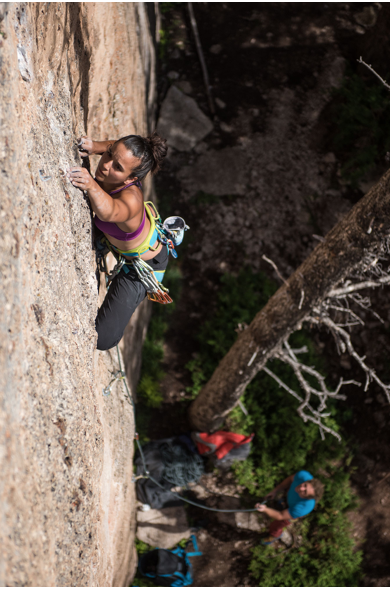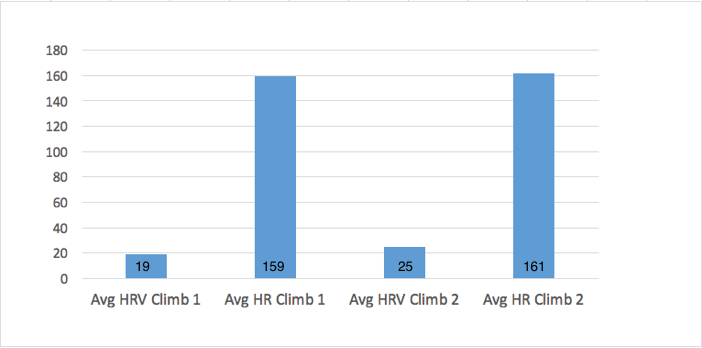
by Colin Montgomery and Lindsay Mann
BACKGROUND
MTI studied the effects of fear-induced stress on ice climbers. We then conducted a follow-up research on our Mini-Study with rock climbers.
The Mini-Study with rock climbers study looked at physiological data of several rock climbers to determine if there is a viable means of measuring the fear of falling rock climbers’ experience while climbing. We wanted to identify this measure and then redo this experiment while implementing strategies to help manage and control the fear these climbers were experiencing.
Our challenge is to differentiate between physical exertion of climbing and the fear of falling climbers experience.
The first study determined heart rate variability (HRV) was the lowest just before falling. Low heart rate variability means that the climber’s heart rate (HR) varied the least indicating a high level of physical exertion denoted by a high heart rate.
We used these lessons learned and applied them to our most current iteration of this study.
METHODS AND STUDY DESIGN
This time we studied two climbers. Climber 1 has been lead climbing for approximately 2 years. Climber 2 has been lead climbing for 10+ years, but most of his climbing is in the traditional climbing style. For this test, both climbers were on sport routes.
During all climbs, we had Climbers 1 and 2 wearing a Zephyr Bioharness to record their heart rate and heart rate variability.
A researcher took notes regarding the route climbed:
- The time each climber started the climb.
- Climb completion duration.
- When bolts were clipped.
- Falls.
- Rests.
- When the climber reached the “crux” or most difficult part of the climb.
Using these notes we were able to correlate the physiological data with what was happening to the climber on route.
We had Climber 1 record her data on her warm up climb, a 10d, to see if we could establish a physiological baseline for this individual while climbing. Then we compared average HR and HRV during her warm up climb (10d), to a climb that pushed her grade (12a).
A climber exhibiting fear or stress has a lower HRV.
HRV is how your heart rate deviates from a constant rhythm. At 60 beats per minute, we’d assume your heart rate is beating every second.
An example of HRV would be the time between your heartbeats changing from a one second interval to a 1.1 second interval to a .9 second interval, etc. rather landing on every second mark exactly.
When relaxed and unstressed, your heart’s beat variability is greater. When stressed by fear, your sympathetic nervous system exerts greater control, and your heartbeat interval becomes very consistent.
We would hypothesize that a climber who exhibits fear has a lower HRV. It is important to note that HRV is affected by exercise as well, which means need to keep the metabolic load consistent for each climb.
Knowing this we expected to see Climber 1’s average HRV to be lower on the 2nd, harder climb, than on her first warm up climb, and expected her average HR to be increased on the second climb.
However, this is not what the data showed.
The graph below compares Climber 1 ’s average HR and HRV between her warm up climb and more difficult climb.

Climber 1’s average HRV was higher on the second climb, which is the opposite of what we predicted. The averages show that she was less stressed on the more difficult climb than on her warm up.
We predicted that on Climber 1’s warm up climb, since it was not a difficult grade for her, that she would have a lower HR and a higher HRV than on the second, harder climb. This would correlate to her being less stressed on her first climb.
We then hoped that we could use the difference in HR and HRV to determine how much her HR increased and HRV decreased. The difference between the first and second climb would then help us to determine how much of the increase in HR and decrease in HRV was due to fear of falling.
This did not hold true. Climber 1’s average HRV increased on the second more challenging climb and we saw minimal increase in HR on the second climb.
One reason for this could be that we had a malfunction with the zephyr bioharness on Climber 1’s first attempt of the 12d. The data we used from was from Climber 1 second attempt of the 12d climb. Another explanation could be that after a few pitches Climber 1 become accustomed to the height and the fear decreased.
Additionally, we looked at both Climber 1 and 2 and compared their HRV verse HR on a 12d (climber 1) and 12a (climber 2).


Climber 1 took two falls on this attempt and Climber 2 took no falls.
In Climber 1’s data the HRV shows a typical decrease in HRV as HR increases but before the climber takes a fall HRV increases again quickly. This “ double hump” (around 6:54 and 12:54) is similar to our findings in our first mini study. It is interesting since it suggests that Climber 1 became more relaxed when she started climbing again just after she fell.
In Climber 2’s data the HRV does not show many fluctuations. This low HRV and increases in HR suggest that the climber was fearful throughout the duration of the climb.
TAKEAWAYS
Based on the data we collected we came to similar conclusions as the first study.
After 60-90 seconds of climbing both Climber 1 and 2 were operating between 75-90% of their maximum heart rate. Due to the physical demands of rock climbing it was once again difficult to determine if the increase in heart rate and decrease in heart rate variability during difficult or exposed parts of climbs is simply due to continued physical effort or whether a central nervous system reaction to fear is causing these changes.
In these studies, we have not been able to identify a consistent and accurate means of identifying a physiological impact of fear.
Measuring the proportion of norepinephrine vs. epinephrine while climbing has been suggested as a possible means of answering this question but accuracy of these hormone measures remains inconclusive and using these measures isn’t feasible for our research design.
Across both the experienced and relatively new lead climbers we saw very similar physiological data suggesting that although experience plays roles in different aspects of rock climbing; rock climbing is a physiological demanding sport and all climbers are exerting themselves at a high level while climbing regardless of experience level.
We are also considering filming these climbers and having them watch their videos. While they are watching this footage we would be monitoring their heart rate and respiration rate to see if these physiological signs increased during risky or fearful parts of the climb. This technique has been used clinically to assess fear and we are continuing to look into the viability of this study design to bring more light to this issue.
REMAINING QUESTIONS
Is there a way to establish a baseline of physiological data for climbers to differentiate between physiological changes caused by fear verse physical exertion?
Ultimately, we are interested in exploring stress inoculation training. Having a physiological measure of fear will help us evaluate training methodology.
Comments, Feedback, Questions? Email coach@mtntactical.com
References:
- Bochanski, Kyle. “Rock Climbing Exposure Mini Study: How Can we Measure Fear?” www. strongswiftdurable.com. June 9, 2016.
- Williams, E. S., Taggart, P. & Carruthers, M. Rock climbing: observations on heart rate and plasma catecholamine concentrations and the influence of oxprenolol. Br. J. Sports Med. 12, 125–128 (1978).
YOU MIGHT ALSO LIKE ROCK CLIMBING EXPOSURE MINI-STUDY: HOW CAN WE MEASURE FEAR?
